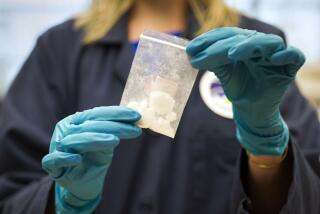Now, China’s fish are suspect
- Share via
SHANGHAI AND LOS ANGELES — Melamine in Chinese-produced milk powder has sickened hundreds of thousands of children and added to a growing list of made-in-China foods banned across the globe. Now, some scientists and consumer advocates are raising concerns that fish from China may also be contaminated with the industrial chemical.
China is the world’s largest producer of farm-raised seafood, exporting billions of dollars worth of shrimp, catfish, tilapia, salmon and other fish. The U.S. imported about $2 billion of seafood products from China in 2007, almost double the volume of four years earlier, according to the U.S. Department of Agriculture.
But industry experts and businesspeople in China say that melamine has been routinely added to fish and animal feed to artificially boost protein readings. And new research suggests that, unlike in cows and pigs, the edible flesh in fish that have been fed melamine contains residues of the nitrogen-rich substance.
Melamine, commonly used in plastics and dishware, can lead to urinary problems such as kidney stones and even renal failure.
Last year, pet foods made with melamine-laced ingredients from China sickened or killed thousands of dogs and cats in the U.S. This year, infant formula tainted with the chemical has been linked to illness in 294,000 small children and six deaths in China, according to China’s Ministry of Health.
In the U.S., fish from China can be found in the frozen food aisle in supermarkets and is served in posh restaurants.
“China’s a big place, and it does a lot of processing, and cheaply too,” said Brian Dedmon, purchasing manager for the Fish King distribution plant in Burbank.
Fish King, which supplies hundreds of Southern California restaurants and has a store in Glendale, says it buys processed snow crab meat, squid and other seafood from China to meet market demand and because the price is competitive. Dedmon says the company relies on government inspections, its importers and its own experience to ensure the fish it buys is safe.
“We’re definitely concerned about melamine, but by the time the fish gets to us, health issues should’ve been taken care of by the government agencies and brokers that we go through,” he said.
Not on the checklist
But even though some U.S. fish importers are voluntarily testing for melamine, the U.S. Food and Drug Administration, which is responsible for ensuring the safety of imported fish, currently doesn’t require seafood products to be screened for melamine. Yet research from its own scientists has raised a warning flag.
Laboratory studies of melamine-fed catfish, trout, tilapia and salmon by the FDA’s Animal Drugs Research Center found that fish tissues had melamine concentrations of up to 200 parts per million. That’s 80 times the maximum “tolerable” amount set by the FDA for safe consumption.
Iddya Karunasagar, a United Nations fish-product safety expert in Rome, said the FDA’s research suggested fish would have to ingest large amounts of melamine to pose a health threat to humans, something that he considered unlikely. But he said there were no data on melamine levels in Chinese-produced fish and animal feed.
Other scientists said testing of melamine in farm-raised fish from China should be made mandatory because of the dearth of information about melamine levels in Chinese feed and fish.
“That’s the problem; no one has a clue how much concentration and for how long” fish from China have ingested melamine, said Jim Riviere, director of chemical toxicology research at North Carolina State University in Raleigh. “There’s an issue of relative human safety,” he said. “It would be prudent to screen for melamine.”
An FDA representative in Washington wouldn’t comment on why Chinese-produced seafood didn’t have to be analyzed for melamine when imported to the U.S. Nor were FDA researchers made available to comment on their agency’s findings, reported recently in the Journal of Agricultural and Food Chemistry.
Research undertaken by Riviere and others show that melamine in feed consumed by pigs and cows is excreted in the urine or otherwise flushed out, leaving virtually no trace of it in the muscle or meat of the animals. But fish appear to be different, toxicologists say.
Fang Shijun, who has monitored the melamine problem for several years, says he believes that the adulterated products are being supplied only by small operators, which abound in China.
Like those who added melamine to milk and diluted it with water to increase profit, feed businesses can sell more by substituting melamine for real protein sources, especially with the cost of corn and other raw materials having soared in the last couple of years.
“It is impossible to calculate how many of them have done that,” said Fang, manager of feed research at Shanghai EFeedLink Information Technology, an agriculture consulting and research firm.
In the U.S., aqua-cultured seafood from China can be found in restaurants and in markets that sell frozen shrimp, catfish fillets and roasted eel, among other fish. U.S. importers such as Boston-based Stavis Seafoods, which sells products under the brand Foods From the Sea, are taking precautions and doing their own testing.
“It’s our reputation behind it,” company Chairman Richard Stavis said. Thus far, he said, the testing has not turned up melamine in the catfish and tilapia that Stavis buys from China.
U.S. importers have for some years been testing for a variety of antibiotics and substances, including the suspected carcinogen malachite green, which some Chinese fish farms use to control disease.
Since last year, the FDA has been restricting entry of shrimp, catfish, dace, eel and basa from China unless those shipments come with an independent lab report certifying the seafood is free of such additives. Melamine isn’t included on that list of additives.
The Chinese government, facing increasing pressure from the public, has begun to crack down on melamine suppliers and has widened inspections to include feed. And many Chinese exporters of farmed fish say government inspectors are coming around more often and examining samples.
But shipments of filthy and contaminated fish from China continue to be detained at U.S. ports, exposing holes in a food-safety system that analysts say is undermined by a lack of resources, corruption and unscrupulous businesses that will sometimes mislabel or reroute goods through other countries.
Last month, 26 containers of shrimp, crawfish, tilapia and other fish from China were refused entry in Long Beach and other U.S. seaports. Inspectors cited a variety of reasons: salmonella, unsafe additives, unapproved drugs and labeling problems, according to FDA records on its website.
U.S. consumer advocates say the FDA has its own resource issues.
“They’re so understaffed at the borders that despite whatever orders they have, we can’t be sure that products aren’t just coming through anyway,” said Jean Halloran, food policy initiatives director for Consumers Union, the publisher of Consumer Reports. “We need much better testing,” she said, including of melamine in fish.
FDA officials last month opened three offices in China, part of a strategy to deploy agency staff in countries where many U.S. foods now originate and where they can work with local inspectors and the industry.
“We cannot inspect our way to import safety; we have to roll our borders back and work with producers and have [their products] certified by people we trust,” said Michael Leavitt, secretary of the U.S. Health and Human Services Department, under which the FDA operates, during a visit to China last month.
A food-source issue
Karunasagar, the U.N.’s fishery expert, said governments in China and elsewhere needed to tackle the problem at the source. “More than the fish, we should monitor melamine in the feed.”
But that’s easier said than done. In the U.S., commercial fish farms have to use feed from a handful of approved suppliers, but in China, there may be hundreds of thousands of sources for feed, said Steve Dickinson, an American attorney in China’s coastal city of Qingdao who ran a salmon-farming business in Washington state.
Melamine has “infected the whole system in China,” he said.
More than 15 feed suppliers in various parts of China were contacted for this story. Most of them declined to comment or said they didn’t add melamine. But some of them said the practice of spiking feed with it had been going on for at least the last six years, with inspectors checking some types of feed products more tightly than others.
“It is not so regulated, for example, in the fish powder industry,” said Zhuge Fulai, manager of Lianfeng Protein Feed Plant in Shandong province.
Fang, the feed research manager in Shanghai, said adulterating feed was particularly rampant in 2003 and 2004. He doubts that many feed suppliers today are adding melamine, given the awareness and the government’s publicized crackdown, but neither he nor anyone else thinks the problem has been eradicated.
“We still need more government supervision,” Fang said. “We need to have more random checks and to fully execute regulations and standards.”
--
tiffany.hsu@latimes.com
More to Read
Sign up for Essential California
The most important California stories and recommendations in your inbox every morning.
You may occasionally receive promotional content from the Los Angeles Times.















